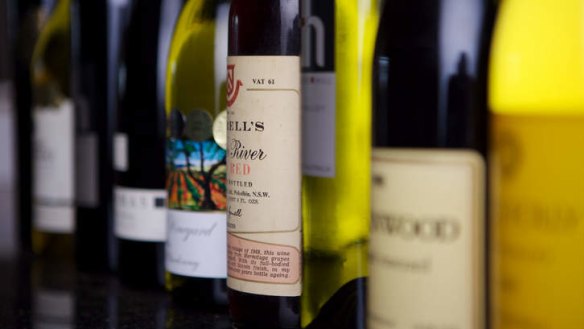Tasting perspectives
In a field of many, some outshine the rest, Chris Shanahan writes.

No contrast could've been starker. Next to a tired and heavy Eden Valley Riesling 1999, a Mosel of the same year seduced with its sweet, delicate freshness.
Australia's Storton Vineyard Rhine Riesling 1999 didn't get a second sniff. But Dr Weins-Prum Spatlese Riesling 1999, from the great Sonnenuhr vineyard at Wehlen, showed the true beauty of the riesling grape. And we savoured it to the hilt.
After this masked tasting (hosted by Jeir Creek's Rob and Kay Howell), we moved into festive mode, away from the formalities of the tasting bench to all the varied and relaxed sipping of the season.
Our first outing, in the Hyatt hotel courtyard, brought home the huge advances of Australia's sparkling wine makers over the last 30 years. On the day, the Hyatt offered Moet et Chandon non-vintage champagne at $85. It's not a bad wine - delicate, in the Moet style, with tiny, lively bubbles, and soft, creamy texture. But where's the excitement? We found more of this at other events in several Australian bubblies costing $50-$60. The most notable, Pirie Tasmania Blanc de Blancs 2007, drank so much better than Moet NV and several discount champagnes we tried over the season.
However, our Christmas champagnes - Pol Roger 1998 and Pol Roger 2000 - provided more drinking pleasure than anything we've seen from Australia. And even these rate a little behind the Krug Grande Cuvee enjoyed a few months earlier at a Clonakilla event. And sublime as it is, Grande Cuvee pales in comparison to our memories of Krug 1985, Veuve Clicquot La Grande Dame Rose 1988 and many other great vintage champagnes savoured during 36 years in the trade.
This demonstrates quite a long pecking order, even at the top of the sparkling wine quality pyramid.
In the few weeks after Rob and Kay Howell's masked tasting, where we enjoyed the Weins-Prum 1999 riesling, Mosel twice lit up our festive season. Over lunch under Chateau Shanahan's 50-year-old gingko tree, J.J. Prum Wehlener Sonnenuhr Riesling Kabinett 2007 started a long afternoon of wine and conversation with Barossa wine merchant David Farmer.
Again, the fresh, delicately sweet Mosel proved irresistible, outclassing an older Australian riesling. Late in the day, however, Canberra's Ravensworth Riesling 2012 held up well as a bright, young palate cleanser. A week or so later, the light, ethereal delicacy of another J.J. Prum Riesling Kabinett 2007 (from the Himmelreich vineyard, Graach) sat beautifully with food by Debbie Skelton.
Pooley Coal River Valley Pinot Grigio 2011 followed Prum's riesling at the same dinner and required a significant palate recalibration. There's nothing subtle about pinot grigio, a mutant of the pinot noir grape. Pooley's, however, proved comparatively delicate for the variety, showing clear varietal flavour without heaviness - a product, presumably, of the cool climate, accompanied by good vine management and winemaking. The only red to distinguish itself on the night, Collector Reserve Canberra District Shiraz 2009, showed the fragrant, spicy elegance of cool-climate shiraz; it's a beautiful wine and still evolving.
During the festive period, we scrolled through the cellar, starting with pinot noir. A couple of old favourites disappointed and remained in the decanter. Likewise, the just-released Holm Oak Tasmania The Wizard ($60) didn't push our pinot buttons. It's a big, ripe, fruity red, impressive for the concentration of fruit flavour, but fails what we call the pinosity test. The similarly priced Bannockburn Geelong Serre Pinot Noir 2007 passed this test with aplomb. More pinots like this, please.
A run of older wines from the cellar provided highlights, surprises and disappointments. ''Curse the cork,'' is my first comment. At one dinner we served two cabernets from the 1986 vintage, a great year in Bordeaux and eastern Australia.
Cork taint ruined the Chateau Pichon Longueville de Lalande 1986, a highly rated wine from Pauillac in Bordeaux's Medoc region. The wine retained a lovely red colour, even at 26 years of age. And beneath the musty, mouldy cork taint, we could appreciate what might have been. So down the sink it went. Its companion, however, showed the great glory of aged cabernet. Penfolds Bin 707 1986 (a blend from Coonawarra and the Kalimna vineyard, Barossa Valley), delivered the sweet, complex, cedary, fruity aroma of age, with a special lift and vibrancy - characters delivered also on the beautiful palate. This is a great wine by any measure, destined to drink well for decades to come.
Few wines blossom like this with bottle age. McWilliams Maurice O'Shea Hunter Valley Shiraz 2003, was OK, but not exciting. Penfolds RWT Barossa Valley Shiraz 2001 gave a little excitement, but nowhere near the heights of Bin 707.
And then out came Majella Coonawarra Shiraz 2002 - a good quaffer, we'd hoped, to accompany a late-night game of 500. Well, what a gem it was, a red of some dimension and all the better for its long rest under Chateau Shanahan. This was elegant, berry-and-spice Coonawarra shiraz, sweet fruited and silky textured.